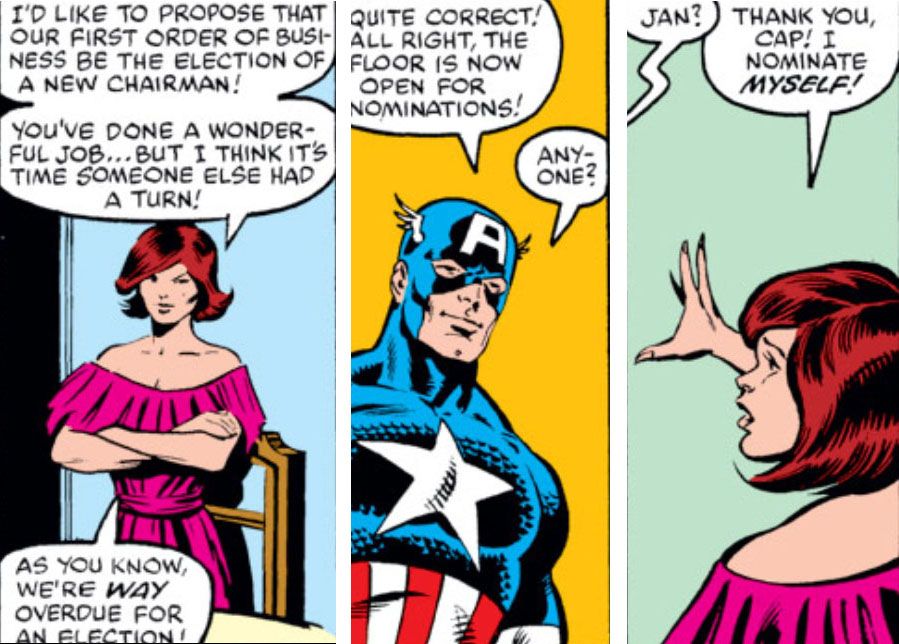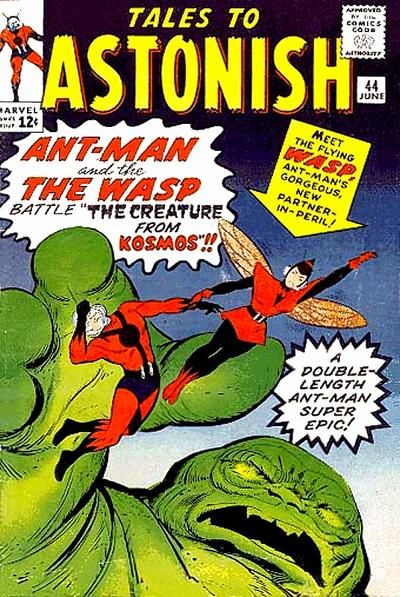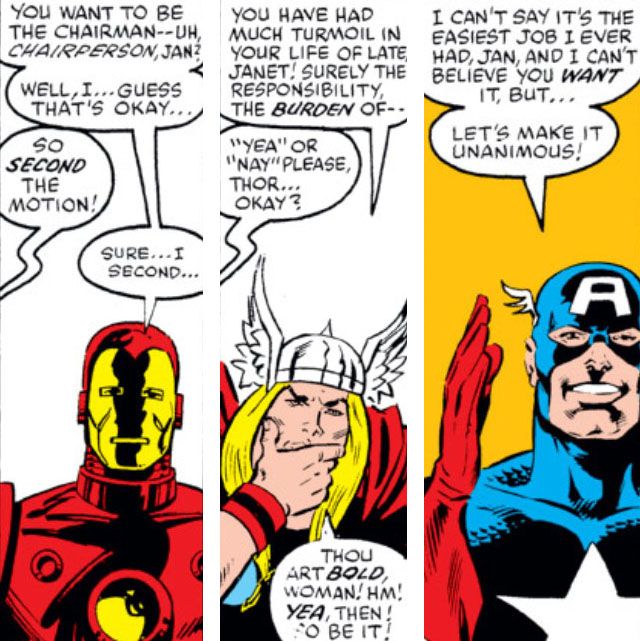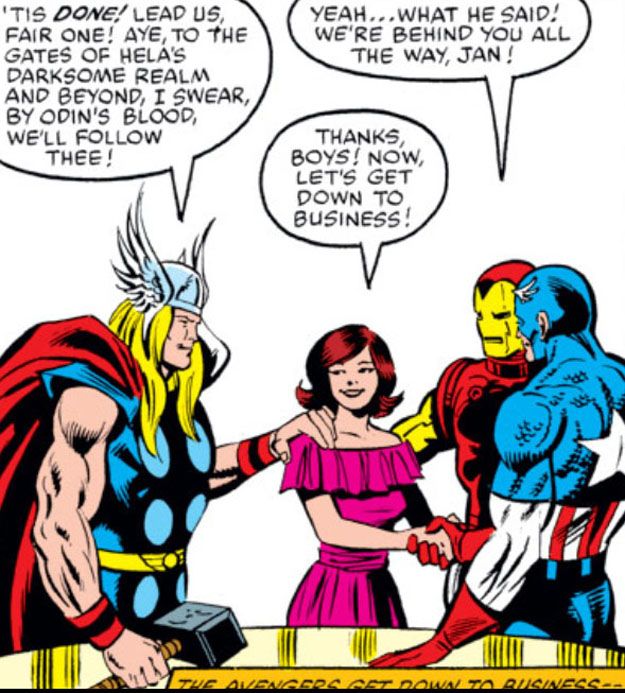Tales to Astonish #44 hit newsstands, and our hearts, in June 1963. The cover promised us a cool, green space monster and the debut of a new character: "Meet the flying Wasp!," we're told and, hey, there she is flying across the front of the book in a triumphant fashion. While she may be Ant-Man's new "partner-in-peril," she doesn't look too imperiled as she carries what looks like a swooning Hank Pym out of the creature's grasp.
The Wasp rarely is the swooning, damsel in distress: She's gone through some peril to be sure, from her personal life to her costumed adventuring career, but this woman doesn't shirk her responsibilities or morals to cower or retire. Technically, she's been an Avenger since the team's inception and remains unique in the field of superheroics: while most heroes have greatness thrust upon them or fight to survive, Janet Van Dyne actively chose this life. She's accepted herself enough to be public about being a "costumed adventurer" and is rich enough to make it her primary occupation with little to no angst about how she got to where she is today. Becoming the Wasp was a way for her to avenge her father's death, and that may have inspired the name for Earth's Mightiest Heroes.
This month is the 50th anniversary of the winsome Wasp and, while most think of her in small terms, her impact on the Marvel Universe is gigantic.
Starting with her origin from the pages of Tales to Astonish #44, what really fascinates me is how she gained her powers and took off for a life of adventure, because it really was her decision. Quick recap: Vernon Van Dyne is working on a "Gamma Ray Beam" device to contact another galaxy (is there anything that Gamma Rays can't do?), tries to get Dr. Hank Pym on board for help, but Pym declines as their fields of science don't jibe. Vernon Van Dyne goes ahead with his project anyway, unwittingly releases a creature from the planet Kosmos and is killed. The monster sets off on a rampage, and Janet comes home to a slain father and a crazy science device gone horribly wrong.
Now, it would be a perfectly normal story beat for Janet to faint right on the scene -- for her to scream or panic or hide, maybe get terrorized a little by the title villain only for Ant-Man to save her. 1963 isn't exactly the time in which women were taken that seriously in science fiction, but here she is, dialing up the last scientist who saw her father alive to tell him the whole story. After some investigating as Ant-Man, wherein we learned that Vernon was killed with "pure fear," Janet Van Dyne (showing some fearlessness) meets again with Ant-Man and Pym before the latter just comes clean as the former. Does she swoon and wait patiently for the day to be saved? Nope, she signs right on up for genetic testing. Experimental genetic testing that Pym hasn't worked on anyone else with. Janet is getting powers to avenge her father's death, and there's no time to waste.
That is what makes her incredible: She really is fearless at an age when fear is a perfectly acceptable response to the situation; ladies in sci-fi thrillers of the day are still the fairer sex, and any horror movie heroine from that era I can think of is still clutching and shrieking in the face of fear. It's a foolish to jump feet first into the science project of a man you just met and then throw on a super-suit to battle a monster from outer space, but here we are. Janet Van Dyne has turned foolishness into heroism in an era when the former was far more expected.
It's a recklessness that causes her to be full of fancy and girlish cliche in future appearances, but please note how she is still standing shoulder to shoulder with some of Marvel's greatest heroes. Ant-Man and the Wasp are a weird choice to be co-founders of the Avengers, but that's the beauty of being Earth's greatest heroes: Sometimes being great isn't about who can punch harder, it's about being brave. The Wasp is the one who dubs this band the Avengers, possibly after her own idea of heroism, and the name sticks. Considering how young she is, she grows up as a member of the team, switching from reservist to active duty as needed. This wasn't a college job for her or a passing fancy; this is a level of commitment we normally praise Spider-Man for. Having lost his father figure because of his own lost moment of selfishness, Peter Parker realized that with great power comes great responsibility. Janet Van Dyne, through no fault of her own, lost her father and devoted herself to avenging his death then and there, and really never stopped.
No matter what, the Wasp has been fighting. Costumed adventurer is her career, right along aside fashion design and being fabulous. She doesn't have a traditional uniform in the sense that she has to put something on to become the Wasp; in fact, she has a whole wardrobe to declare herself to the public and evil-doers everywhere. And yes, it's incredibly sad that her personal life has eclipsed her heroic calling, but even then, at her worst, Janet doesn't stop fighting. After Hank's meltdown, Janet again would have a right to retire, to rethink her choice to get mixed up in all this superhero nonsense, at least take a long vacation somewhere far away. Instead, just four issues later, she steps up and lays out her plan to become chairwoman of the Avengers. Although her teammates are perplexed (below), she demands straight answers from them and winds up getting a unanimous vote in. Thanking them graciously, they get down to business. As Avengers chairwoman, she recruits both She-Hulk and Monica Rambeau (as Captain Marvel), she leads the team through one of the darkest storylines of the time in "Under Siege," and she even buys them a Quinjet! The Wasp will never stop fighting.
The Wasp won't stop being herself, either. Her powers have remained relatively the same for 50 years (we do not talk about "The Crossing"); even with the ability to grow to giant-sized, she's stuck to the small and dangerous life. Sure, she's been an "airhead heiress," but the Wasp hasn't shied away from the moniker, knowing full well that it was a valid description in her younger years. When she was removed from the Marvel Universe, there was something missing in a long-lasting female champion in our grand cast of heroes. Not as strong as the Hulk or as tough as Thor, but she is as valiant as any of them and it is because of those limitations that she deserves even more respect as an inspiration to never stop fighting.




